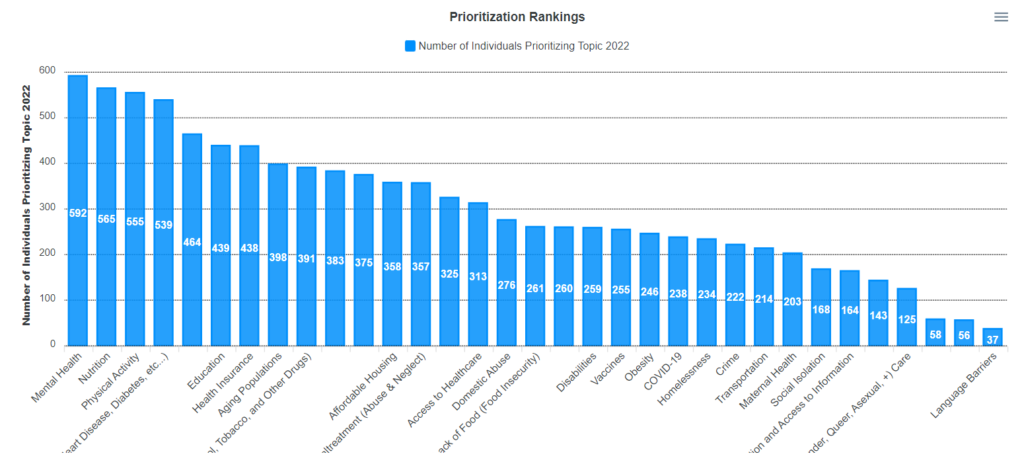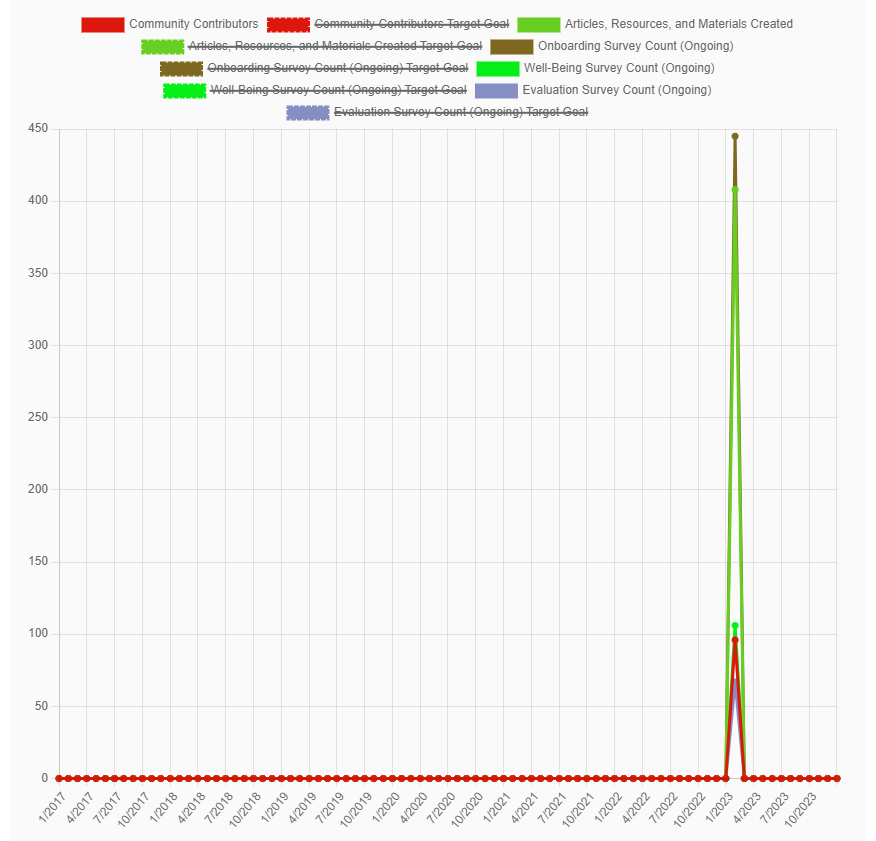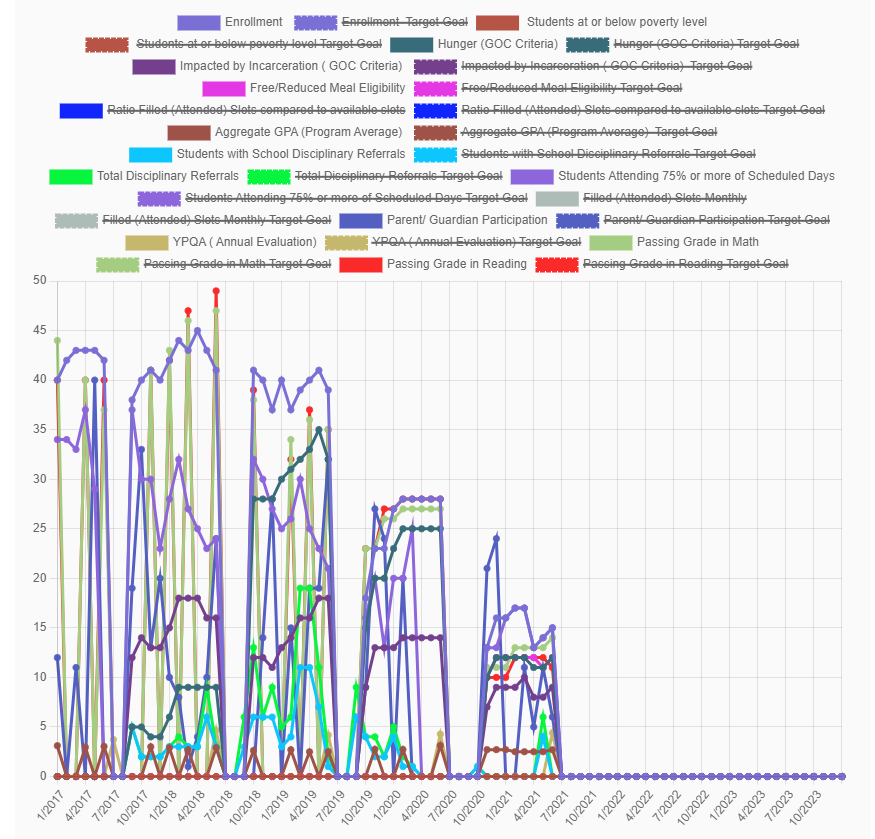DATA INSIGHT
B: Food and Nutrition SecurityCommunity Story
Many strategies and interventions to help people choose healthy foods are underway and can help reduce the risk of chronic diseases and improve their overall health. People who eat too many foods that are high in saturated fat and added sugars are at an increased risk for obesity, heart disease, type 2 diabetes, and other health issues.
Some people don’t have the information they need to choose healthy foods. Other people don’t have access to healthy foods or can’t afford to buy enough food. The USDA defines food insecurity as a lack of consistent access to enough food for every person in a household to live an active, healthy life. Hunger is the feeling someone has when they don’t have enough food.
Our community checked the box broadly titled nutrition enough times that it landed as the second issue of concern. As we explore the issue, keep in mind the complexities presented and that we don’t know from our broad health assessment data what specifically it is about nutrition that concerns people the most. Is it that they are hungry, food insecure, struggling with obesity, diagnosed with type 2 diabetes, or want to learn new recipes?
Sources:
1. U.S. Department of Agriculture and U.S. Department of Health and Human Services. Dietary Guidelines for Americans, 2020-2025. 9th Edition. December 2020. Available at DietaryGuidelines.gov.
2. https://www.ers.usda.gov/topics/food-nutrition-assistance/food-security-in-the-u-s/
3. U.S. Department of Health and Human Services, Office of Disease Prevention and Health Promotion. Healthy People 2030: Social determinants of health.
Data Story
Telling a story about our data is vital to understanding the impact of programs, systems, and improvement efforts in our community. Here’s the baseline data we have from our current Community Health Assessment regarding mental health. These datapoints are a collection of surveys and research, and provide information for our community to comprehensively create strategies. These datapoints are not comparative outside of the individual survey instruments.
Below you’ll find our own primary data sets and the secondary sources that help us know more about nutrition and food security in Garrett County. We have real-time data sets, so anyone in the community can see how a given program or intervention is performing and join in the effort on mygarrettcounty.com. Contact information is available for leadership in the area of nutrition, as well as a list of coalitions open to the public that address various issues related to nutrition and food security. Current community resources and relevant areas of interest are also included.
Here’s the baseline data we have from our current Community Health Assessment regarding nutrition and food security. These data points are a collection of surveys and research to provide information for our community to comprehensively create strategies. These data points are not comparative outside of the individual survey instruments.
Assessment Data
A interative version of this graph, with additional data, is available at: https://charp.garrettcountyapps.com/
A interative version of this graph, with additional data, is available at: https://charp.garrettcountyapps.com/
Focus groups were held in a guided conversation format about the top five issues people identified as their main concerns in our latest community prioritization survey. Below is the analysis of the focus group discussions conducted in June of 2022. To read the full analysis visit https://mygarrettcounty.com/cha2024/, and select the assessment narrative on page 10.
Focus Group Analysis
Nutrition as a priority was ranked second. Three years ago, it was ranked 14th – that’s a 207% increase reported in consumer surveys. Focus group discussions centered around food insecurities and a lack of adequate nutrition in common food choices. Certain shortages at grocery stores during 2020 had a lasting impact on many. People were genuinely concerned about the future as it relates to food access. Senior citizens and younger school-aged children were frequently referenced as examples of groups impacted. These may be two of the most vulnerable demographics for hunger, and data may be difficult to obtain to delve deeper into this issue. Other themes discussed were challenges with our short growing season and needing to figure out what to do with fresh produce when there’s an abundance. Barriers of expense and expertise to canning, freezing, and storing food were also discussed. Many felt they didn’t have the time to eat healthy meals or prepare food. Simple recipes the whole family would enjoy was a common request in the focus groups. Meal planning and the idea of food as medicine were proposed as possible solutions to enhancing nutrition to save time. Another community member had the idea of hosting a “long table” where community members bring dishes and everyone tries something new and takes home the recipe. Farmer’s co-ops and fresh markets, when in season, are accessible to some, but there are still gaps in remote communities, so expanding those programs could be helpful.
MyGarrettCounty.com Action Group Data (Real-Time Data)
Food Council
https://mygarrettcounty.com/groups/social-determinants-of-health/raw-data/

Ad Hoc Committee on Diabetes
https://mygarrettcounty.com/groups/ad-hoc-committee-on-diabetes/raw-data/
Early Care Programs System of Care
https://mygarrettcounty.com/groups/early-care-programs-system-of-care/raw-data/

Improving Healthy Birth Weights
https://mygarrettcounty.com/groups/improving-health-birth-weights/raw-data/
Go! Garrett County
https://mygarrettcounty.com/groups/go-gc/raw-data/

Learning Beyond the Classroom
https://mygarrettcounty.com/groups/learning-beyond-the-classroom/raw-data/
Partners After School @ Oakland
https://mygarrettcounty.com/groups/partners-after-school-oakland/raw-data/

WIC Nutrition Increases Fruit and Vegetable Consumption
https://mygarrettcounty.com/groups/wic-nutrition-increases-fruit-and-vegetable-consumption-1738748979/raw-data/


Supplemental Primary Data
Garrett County Pandemic Health Assessment
https://mygarrettcounty.com/cha2024/
When the United States went into lockdown, various agencies supported vulnerable populations and food insecurity needs. The Office of Population Health, Innovation, & Informatics helped to manage interagency coordination through the Health Planning Council via a baseline survey. The intent was to utilize the data to begin coordinating local systems.
What’s unique about this survey is that within an hour of launching the survey we had over 1000 responses. This was a time when our community faced much uncertainty. We needed data specifically about food resources to set up collection sites. During this time, the survey method worked well for public health to have the data to take action.
Q6 What is your greatest concern at this moment?
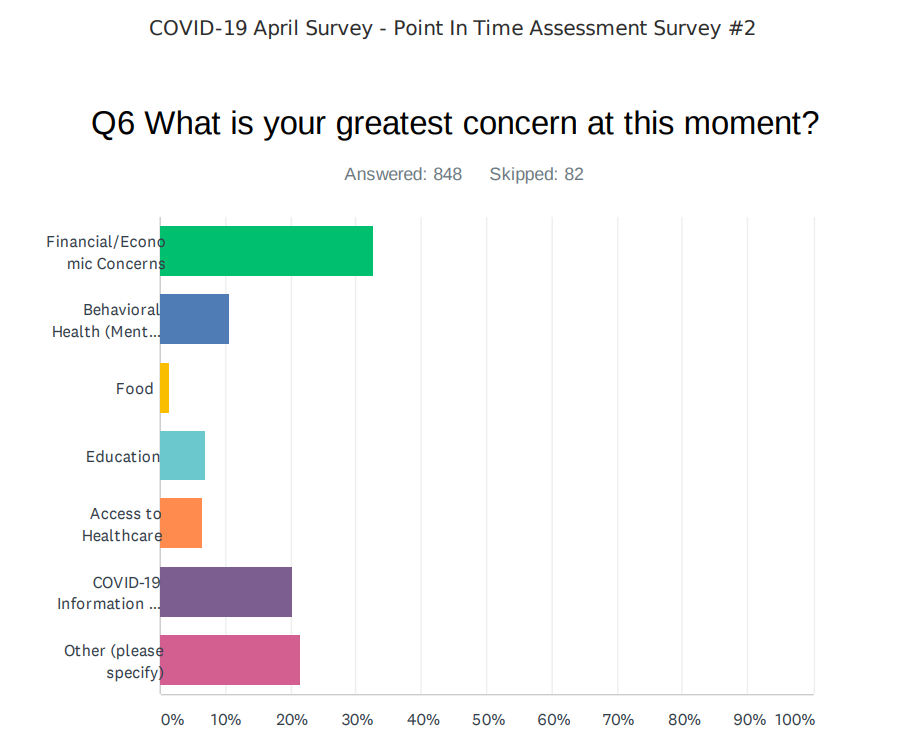

Well-Being Dataset: Go! Garrett County
https://mygarrettcounty.com/cha2024/ + Additional Data Collected
Originally funded by Maryland’s Community Health Resource Commission, Go! Garrett County.com is an innovative way to provide engagement and education while promoting local resources, and acting as the only data the county has collected about belonging. The longitudinal surveying on the website creates a knowledge base we are using to tailor specific programs to prevent and manage chronic diseases in Garrett County. In evaluation, only 7.35% of participants did not report any improvement in their overall well-being as a result of participation in this initial community-wide program. These datasets provide additional supporting evidence that non-medical interventions can improve well-being. Additional datasets from this program, including statistically significant databases of geospatial burden of chronic diseases and BMI distribution are also available for further evaluation, if funding allows.


Garrett County Public Schools Data
View on Maryland Public Schools’ Website: https://bit.ly/4437ZBx
Primary Fiscal Year 2022 Data From the Garrett County Health Department’s Health Education & Outreach Unit:
26 Diet Consults Completed
792 Elementary / Middle School Students Completed Healthy Eating Challenges w/ Play Hard Live Clean
178 Healthy Eating Challenges Completed by High School Students
37% of Adults Reported Improved Knowledge of Healthy Eating as a Result of Education
53% of Youth Reported Improved Knowledge of Healthy Eating as a Result of Education
Primary Data from the Garrett County Department of Social Services:
1) Total Count of Participants receiving SNAP in July for each year from 2017-2022:
July 2017 – Unavailable
July 2018 – Unavailable
July 2019 – Unavailable
July 2020 – Unavailable
July 2021 – 2351 CASES
July 2022 – 2172 CASES2) Total count of participants receiving SNAP:
Jan 2023 – 4640 clients total (2277 CASES/HOUSEHOLDS)
Feb 2023 – 4630 clients total (2295 CASES/HOUSEHOLDS)April – September Data:
Unique Cases (Households)
April 2271, May 2245, June 2258, July 2219, August 2211, September 2208
# of Issuances (Individuals)
April 4585, May 4557, June 4586, July 4555, August 4560, September 45453) The total dollar amount awarded in 2022:
$12,618,534.31
4) The average dollar amount participants lost due to the ending of SNAP Covid funds:
Feb 2023 Issuance $1,146,434.33/2295 CASES = $499.54 per CASE/month of 2/23
Mar 2023 Issuance – Unknown at this time5) How DSS staff is helping families prepare for the reduction in benefits:
– GCDSS Website and Facebook pages
– Staff at monthly outreach locations – libraries, senior centers
– Staff invited by CAC to all Senior apartment buildings in March for question/answer session
– Flyers sent to community partners
– Available in person, by phone/email to answer questions and explain personal benefit changes6) What community supports/coordination would help your clients the most as it relates to food security
We need a place where GC citizens can pick up weekly groceries – mostly staples. I had a gentleman come in, he had called the House of Hope and was referred to a food bank. He was told that weekly pickup was not available due to supply. This is where community available supplies would go a long way – especially in support of the aging population on a fixed income.
Additional Notes of Importance:
MA Unwinding – Public Health Emergency ends May 11; we have not been able to close any MA cases during this time, except of in 5 instances (move, death, better coverage, etc.)
– In preparation for this, redetermination dates have been extended to the date of their original start date (total of 12 cohorts for each month of the year).
– MDH will return to standard redetermination mailings for the first of 12 cohorts in April 2023.
– The first disenrollments for participants of the first cohort who no longer qualify for coverage will occur on May 31st. The first day without Medicaid coverage for these beneficiaries will be June 1, 2023.
– The unwinding process will continue over12 months with the remaining cohorts. This is done to spread out the number of coverage end dates over that time.
– This plan is posted on the MDH website: https://health.maryland.gov/mmcp/Pages/2023-MMAC-Meeting-Materials.asp
Secondary Data
A substantial amount of secondary data on nutrition and food insecurity is available in the 2022-2024 Garrett County & Surrounding Region Community Health Assessment (https://mygarrettcounty.com/cha2024/) and accompanying supplemental data reports. Highlights from this combined document are included below:
SNAP Benefits

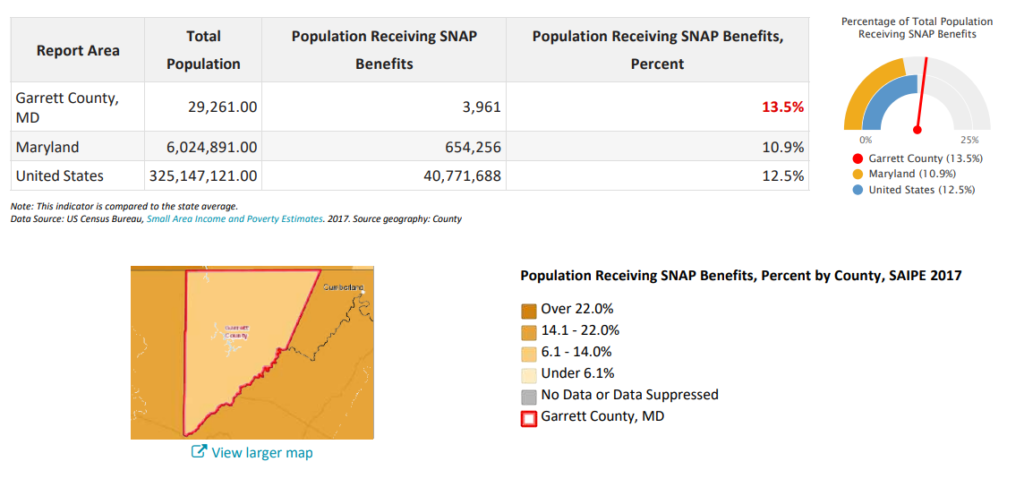

SNAP Authorized Stores

Fast Food Restaurants
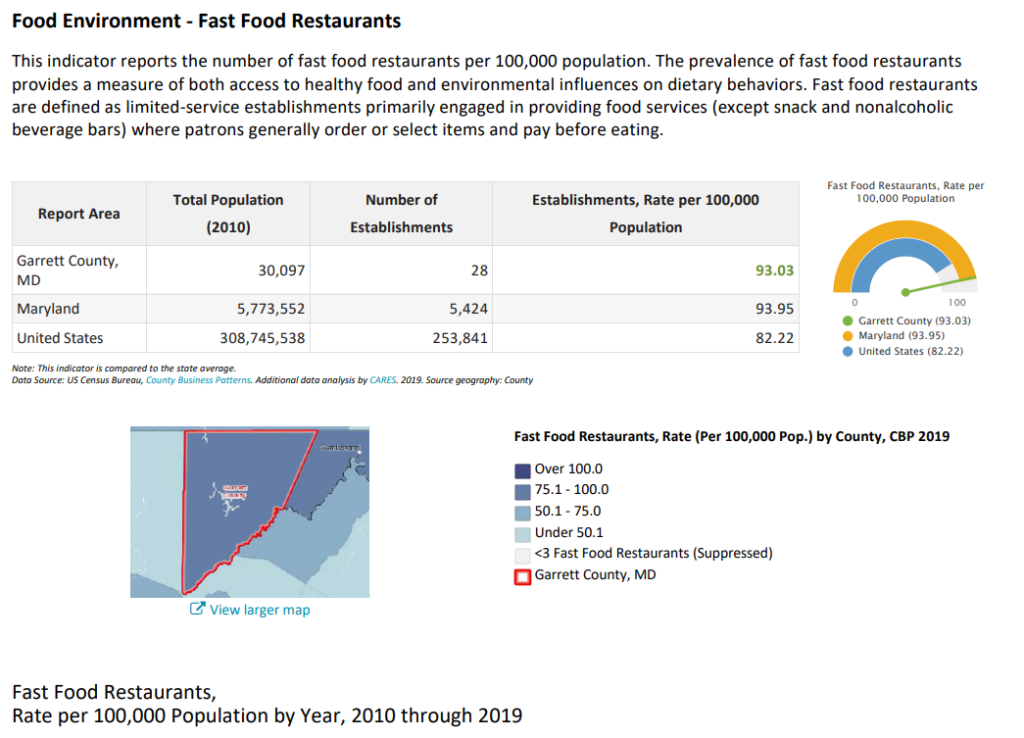

Food Deserts

Grocery Stores



Take Action
Leading Systems Change
Health Strategist, Shelley Argabrite and her team at the Garrett County Health Department are leading the charge to create infrastructure in the form of a nonprofit with a multisector board which will aid in the ease of resource coordination to address food and nutrition security in Garrett County. Partners from the University of Maryland Extension, Garrett Growers, and Garrett County Government are integral partners in the effort.
This collaboration is made possible through funding from the Center for Chronic Disease Prevention and Control at the Maryland Department of Health. For the second year, the grant award, State Partnerships Improving Nutrition & Equity (SPINE), will support community collaborations through the Health Planning Council to promote food and nutrition security and stand up sustainable efforts.
Additional partners from the Western Maryland Food Council, Garrett County Farm Bureau, Mountain Fresh Farmers Markets, and others are sharing their thoughts. We’ve voted on a name for the nonprofit, Appalachian Farm & Food Alliance, Inc.
To be a part of these meaningful efforts to make Garrett County hunger-free, visit mygarrettcounty.com and join the Food Council action group found here, https://mygarrettcounty.com/groups/social-determinants-of-health/. Follow the progress with real-time data reporting and get updates to stay informed.
UPDATE: Community Non-Profit
Appalachian Farm & Food Alliance, Inc was formed June 5, 2023.
- Chair – Willie Lantz
- Vice Chair – Shelley Argabrite
- Treasurer – Melissa Bolyard
- Secretary – Cheryl DeBerry
In addition to the initial funding received from the Maryland Department of Health SPINE award with collaboration from the Garrett County Health Department’s Population Health, Innovation, and Informatics Unit to establish the Appalachian Farm and Food Alliance, Inc. (AFFA). Additional funding has been received for AFFA through the Maryland Department of Health SPINE program to update, print, and publish the food resource brochure, titled Hungry as well as create educational materials to promote healthy cooking.
More new partnerships are forming:
An MOU was signed establishing a collaborative partnership between the Montgomery County Food Council, Western Maryland Food Council, and Appalachian Farm and Food Alliance to support a community of practice of local food councils throughout Maryland with an award of $20,000 given to the Appalachian Farm and Food Alliance, Inc.
New Funding Award: September 2023
The Center for Chronic Disease Prevention and Control (Center) at the Maryland Department of Health awarded funding to the Garrett County Local Health Department for the Community Supported Agriculture (CSA) LHD Project.
The Garrett County Harvest Hub is a new program created by the Garrett County Health Department’s Population Health, Innovation, and Informatics Unit to increase access to Community Supported Agriculture (CSA) opportunities, expand and educate local farmers on SNAP, and improve SNAP recipients’ utilization of local food systems and fresh foods to prevent and reduce chronic diseases.
Community Services & Links
Food Resources Brochure
https://louddoc.com/gcfood
Garrett County Resource Guide
https://mygarrettcounty.com/garrett-county-resource-guide/
Go! Garrett County (w/ Garrett Growers Veggie Boxes)
https://gogarrettcounty.com/
Garrett County Community Food Network
https://garrettcountyfood.com/
Garrett County Harvest Hub Action Group
https://mygarrettcounty.com/groups/garrett-county-harvest-hub/
Materials & Media
MDH Awards Funding to GC Health Planning Council to Increase Food Security
https://garretthealth.org/mdh-awards-funding-to-gc-health-planning-council-to-increase-food-security/
High School Students Prepare Local Food to Improve Wellness
https://garretthealth.org/high-school-students-prepare-local-food-to-improve-wellness/
References & Resources
Related Garrett County Action Groups:
Food Council Action Group
https://mygarrettcounty.com/groups/social-determinants-of-health/
Point(s) of Contact:
Shelley Argabrite, Health Strategist &
Director of the Population Health, Innovation & Informatics Unit
Garrett County Health Department
301-501-6161
[email protected]
Melissa Bolyard, Agriculture Business Specialist
Garrett County Department of Business Development
301-334-7285
[email protected]
Willie Lantz, Extension Educator
University of Maryland Extension
301-334-6961
[email protected]
Cheryl DeBerry
Broadband & Energy Manager
Department of Technology & Communications (DoTCom)
301-334-6968
www.garrettcounty.org/broadband
Current Coalitions or Monthly Meetings
Health Planning Council
Campaigns & Awareness Months
Garrett County Food Access & Infrastructure Initiative
https://gogarrettcounty.com/garrett-county-food-access-infrastructure-initiative/
Go! Garrett County
https://gogarrettcounty.com/
Supplemental Reports:
2023 Maryland Hunger Profiles
https://www.mdhungersolutions.org/wp-content/uploads/2023/09/2023-MD-HUNGER-PROFILES.pdf
Written and coordinated by the Population Health, Innovation, & Informatics Unit at the Garrett County Health Department. This health planning, improvement, and strategy division continues to foster a community of collaboration in Garrett County, Maryland. Join us at MyGarrettCounty.com!
Insight Partners
Currently Participating Partners:
This section coming April 2023!
Interested? Email [email protected] to find out how to participate in this insight and get connected with Action Groups on MyGarrettCounty.com working on strategies related to this insight!
Updated October 2023
Coordinated by the Garrett County Health Department’s Population Health, Innovation, & Informatics Unit under the direction of Garrett County Health Planner & Health Strategist Shelley Argabrite, MA
Powered by the Garrett County Health Department, w/ the support of our amazing community partners.
Assistance for Individuals with Disabilities | Website Accessibility Assistance | Payments
